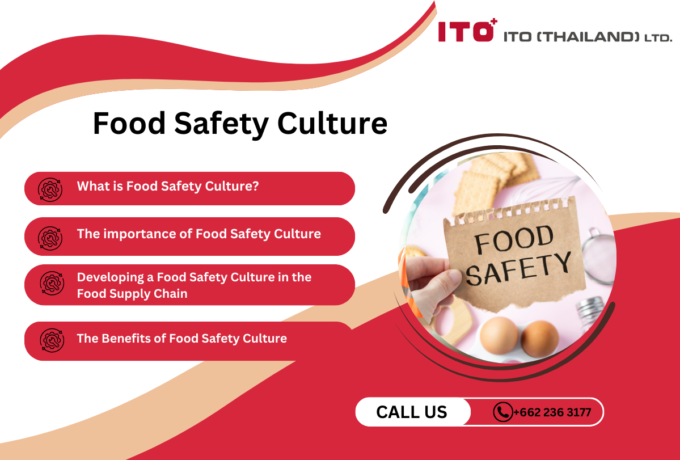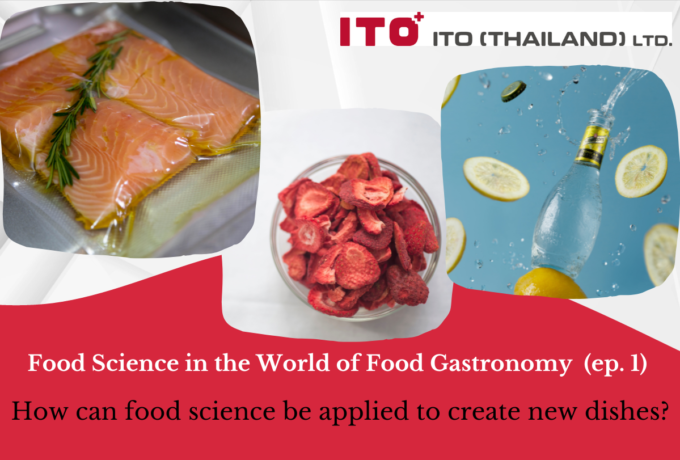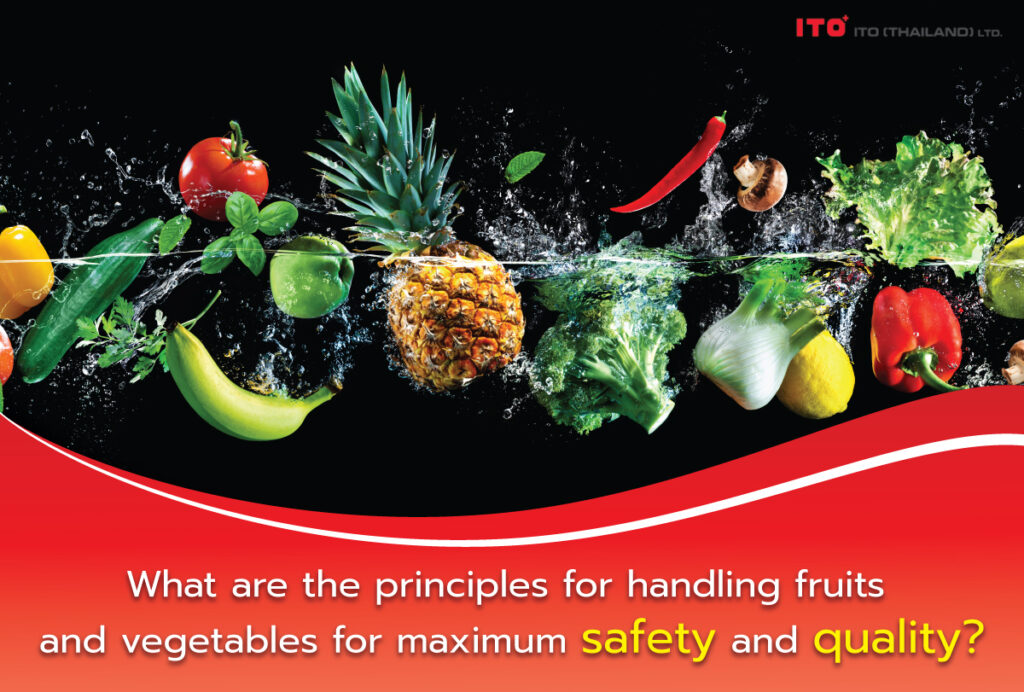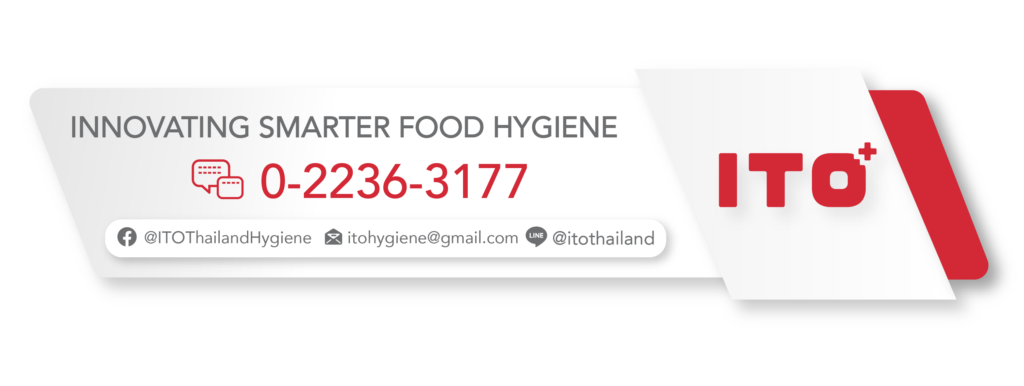ITO Thailand Hygiene Blog
Raw Material Management (Fruit and Vegetable Products)
Examples of contamination risks
Contamination can occur at any time if without proper guidelines. The most obvious example is soil contamination such as crops planted on river banks may be contaminated by various chemicals released into the river and contaminated with E. coli bacteria which may be found from excrement of both human and animal or may be contaminated by manure derived from animal dung, etc.
According to the news in December 2021, Denmark reported 68 cases of patients got sick by severe diarrhea [1] and later 3 were reported dead [2]. After investigation, this group of patients was found eating salad which contained the spring onions imported from Egypt where the spring onions were found contaminated with E. coli strains O136:H7 and O96:H19 including Shigella which cause food poisoning and dysentery [3]. Another example of contamination was the news in February 2022 that Mexico reported the patients more than 1,000 cases between May and December 2021 got sick after consuming onions contaminated with Salmonella [4]. Fortunately, no death was reported. However, Salmonella is very dangerous because if food is contaminated, the look, smell and taste of food are usually not different from the original.
We can reduce the risk of contamination simply by maintaining good hygiene, eating heated food and eating immediately after cooking or within 4 hours because most of the food we eat is outside the safe temperature range [5] between 5-60 degrees Celsius causing a risk of pathogen growth in multiple.
Prevention of contamination from entrepreneur’s perspective
As an entrepreneur and food processor, consumer safety is a big responsibility. Therefore, the quality and safety management system for raw materials is one of the most important functions that cannot be overlooked.
Traceability system which can be traced back at every step from production, processing and distribution of raw materials, additives, ingredients, packaging of which all sources must be traceable for the total recall of the production lot in case of contamination for the benefit and health of consumers; for example, the spring onions contaminated with E. coli in Denmark and the onions contaminated with Salmonella in Mexico. The traceability system usually contains the necessary information including the name and address of manufacturer, production date and lot, etc. [6]
Traceability technology is currently used to help managing the supply chain including the prevention of food terrorism to maintain the food safety and quality. For example, Woolworths Supermarkets in Australia collaborate with farmers, agencies and government sector in using IoT technology, blockchain, data analytics system and quality inspection sensors to check the information of the product in real time which stage of supply chain the product is. And in case of disasters, such as forest fires and floods, it can report immediately which kinds of plants or vegetables that are at risk of damage and assess the solution evaluation from the information obtained [7]. The traceability system is, therefore, recognized to be very useful for all parties concerned either the manufacturers, distributors or consumers.
Purchase and storage to extend product shelf life as a consumer
Simple principles for consumers in choosing to purchase fruits and vegetables are:
1.Shop at the right store; for example, the store that sells only fruits and vegetables tends to have higher quality inspection criteria than a general store that sells a variety of goods.
2.Observe the appearance whether there is an abnormality, no bruise, uniform color, no unpleasant smell or not. If purchased from a store with a discount, special caution should be paid because bruise is an entryway for bacteria that spoils the fruit and vegetable and causes a shorter shelf life. The goods of this category usually have lower quality resulting to shorter shelf life.
3.Store properly. Since various vegetables and fruits have different environmental conditions and suitable temperature for storage. For example, between fruits and vegetables of low temperature group (2-6 °C), including apples, oranges, passion fruits, avocados, and fruits and vegetables of high temperature group (more than 13 °C) when stored in the right temperature, it will help to slow down the quality deterioration but if stored in a too cold temperature, the damage called chilling injury may cause the fruits or vegetables to deteriorate by turning dark, having lesions on their surfaces, etc. [8][9], including ethylene which is a plant hormone that accelerates the ripening of fruits and vegetables such as tomatoes, bananas and apples. Fruits and vegetables naturally release ethylene gas. Therefore, if the ripe fruit is stored with the unripe one, it will accelerate the ripening causing the unripe fruit to have a shorter shelf life, etc. [10]
Proper handling of fruits and vegetables directly affects their quality and safety with details that cannot be overlooked. We should pay more attention to the handling and storage of raw materials due to good quality raw materials will lead to good quality food with nutritious value and safe for consumption.
References
1.Joe Whitworth. Spring onions from Egypt suspected in Danish E. coli outbreak [Internet]. 2021 [Cited 19 Apr 2022]. Available from https://www.foodsafetynews.com/2021/12/spring-onions-from-egypt-suspected-in-danish-e-coli-outbreak
2.Joe Whitworth. Three people died in Danish E. coli outbreak; dozens more infected [Internet]. 2022 [Cited 19 Apr 2022]. Available from https://www.foodsafetynews.com/2022/03/three-people-died-in-danish-e-coli-outbreak-dozens-more-infected
3.National Food Institute. Shigella [Internet]. 2015 [Cited 19 Apr 2022]. Available from http://fic.nfi.or.th/foodsafety/upload/damage/pdf/Shigella.pdf
4.Coral Beach. Onion outbreak is over but FDA continues investigation; more than 1,000 sickened [Internet]. 2022 [Cited 19 Apr 2022]. Available from https://www.foodsafetynews.com/2022/02/onion-outbreak-is-over-but-fda-continues-investigation-more-than-1000-sickened/
5.Food Standards Australia New Zealand. Temperature Control [Internet]. 2022 [Cited 19 Apr 2022]. Available from https://www.foodstandards.gov.au/consumer/safety/faqsafety/pages/foodsafetyfactsheets/charitiesandcommunityorganisationsfactsheets/temperaturecontrolma1477.aspx
6.Food Standards Australia New Zealand. Food Traceability [Internet]. 2017 [Cited 20 Apr 2022]. Available from https://www.foodstandards.gov.au/industry/safetystandards/traceability/pages/default.aspx#:~:text=Traceability%20is%20the%20ability%20to,point%20in%20the%20supply%20chain.
7.Good Fruit & Vegetables. Traceability technology tested for produce tracing system in natural disaster scenarios [Internet]. 2022 [Cited 20 Apr 2022]. Available from https://www.goodfruitandvegetables.com.au/story/7555208/trial-tests-produce-tracing-system
8.Department of Agriculture and Fisheries, Queensland Government. Recommended storage temperatures for fresh produce [Internet]. 2022 [Cited 20 Apr 2022]. Available from https://www.publications.qld.gov.au/dataset/b79225ec-0136-4eb3-b4a3-8e0bc221e725/resource/df0df8ce-f668-4ecf-a4f0-d1b3f4a4ea20/download/storage-temperatures.pdf
9.Pest and Disease Information Service (PaDIS), Government of Western Australia. Storage of fresh fruit and vegetables [Internet]. 2016 [Cited 20 Apr 2022]. Available from https://www.agric.wa.gov.au/fruit/storage-fresh-fruit-and-vegetables
10.Chang, C. Q&A: How do plants respond to ethylene and what is its importance? BMC Biol 14, 7 (2016). https://doi.org/10.1186/s12915-016-0230-0
Related Post
-

Food Safety Culture
Food safety culture plays a crucial role in safeguarding the company's reputation, ensuring the well-being of its employees, and providing a safe experience for its customers.
-

New food source safety issues
What are safety issues worth knowing for trendy new food sources like plant-based and insect-based proteins?
-

British Retail Consortium (BRC) Standard
Food safety management systems play a vital role in ensuring the production and distribution of safe and high-quality food products to consumers. With the global food supply chain becoming increasingly complex, food businesses must implement effective systems prioritising safety, quality, and compliance with industry standards. A food safety management system encompasses a set of procedures, processes, and controls designed to identify, prevent, and manage potential hazards at every stage of the food production and supply process. This proactive approach not only safeguards consumers' health but also protects the reputation and credibility of food companies in an ever more competitive market.
-

Food Science in the World of Food Gastronomy (Part 1)
How can food science be applied to create new dishes?
-

FSSC 22000
Food manufacturers must ensure food safety standards and processes. FSSC 22000 is an official certification program for Food Safety Management Systems (FSMS) recognised by the Global Food Safety Initiative (GFSI). This certification scheme offers a set of guidelines and procedures to ensure uniformity, openness, and safety across your entire supply chain. It applies to all companies operating within the food and beverage industry, ranging from farmers to retailers. By fulfilling the necessary criteria and obtaining FSSC 22000 certification, it is demonstrated that the required standards for food quality and implementing effective processes to manage and mitigate risks associated with food fraud, foodborne illnesses, expensive recalls, and other external threats are met.
-

Food Safety Aspects of Artificial Sweeteners
Artificial sweeteners, also known as sugar substitutes, non-nutritive sweeteners, or high-intensity sweeteners, are artificially produced compounds utilised in place of sucrose (table sugar) to add sweetness to food and drinks. Due to their significantly higher sweetness than regular sugar, only a fraction of artificial sweeteners (200 to 20,000 times less) is required to achieve an equivalent level of sweetness. Since the caloric contribution of these sweeteners, when used in such small quantities, is insignificant, they are often referred to as non-nutritive (4).










